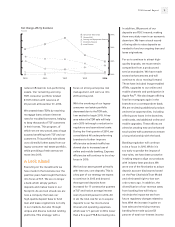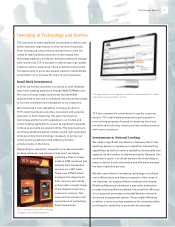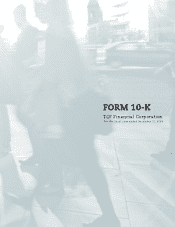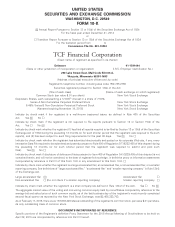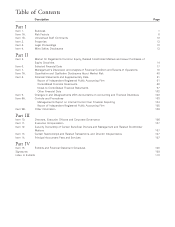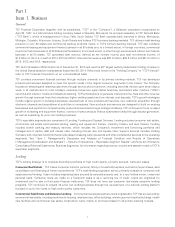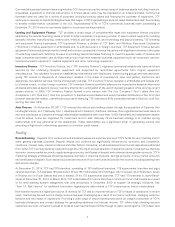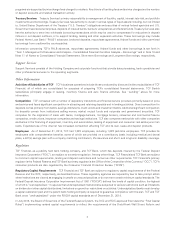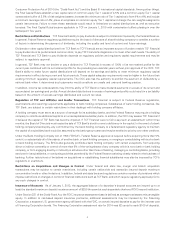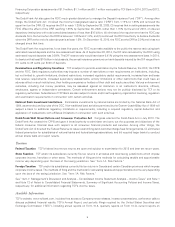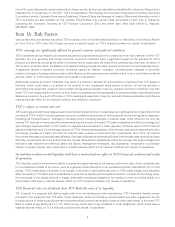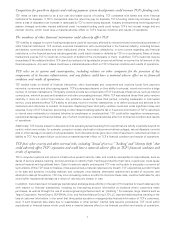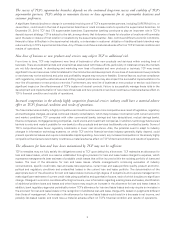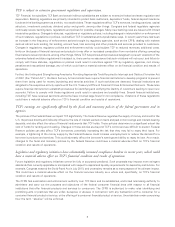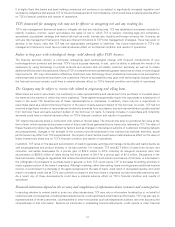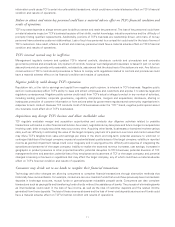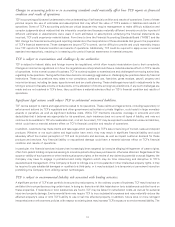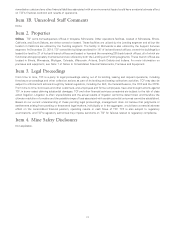TCF Bank 2014 Annual Report Download - page 16
Download and view the complete annual report
Please find page 16 of the 2014 TCF Bank annual report below. You can navigate through the pages in the report by either clicking on the pages listed below, or by using the keyword search tool below to find specific information within the annual report.programs are supported by interchange fees charged to retailers. Key drivers of banking fees and service charges are the number
of deposit accounts and related transaction activity.
Treasury Services Treasury Services’ primary responsibility is management of liquidity, capital, interest rate risk, and portfolio
investments and borrowings. Treasury Services has authority to invest in various types of liquid assets including, but not limited
to, United States Department of the Treasury (‘‘U.S. Treasury’’) obligations and securities of various federal agencies and U.S.
Government sponsored enterprises, deposits of insured banks, bankers’ acceptances and federal funds. Treasury Services also
has the authority to enter into wholesale borrowing transactions which may be used to compensate for reductions in deposit
inflows or net deposit outflows, or to support lending, leasing and other expansion activities. These borrowings may include
Federal Home Loan Bank (‘‘FHLB’’) advances, brokered deposits, repurchase agreements, federal funds and other permitted
borrowings from creditworthy counterparties.
Information concerning TCF’s FHLB advances, repurchase agreements, federal funds and other borrowings is set forth in
‘‘Item 7. Management’s Discussion and Analysis – Consolidated Financial Condition Analysis – Borrowings’’ and in Note 10 and
Note 11 of Notes to Consolidated Financial Statements, Short-term Borrowings and Long-term Borrowings, respectively.
Support Services
Support Services consists of the Holding Company and corporate functions that provide data processing, bank operations and
other professional services to the operating segments.
Other Information
Activities of Subsidiaries of TCF TCF’s business operations include those conducted by direct and indirect subsidiaries of TCF
Financial, all of which are consolidated for purposes of preparing TCF’s consolidated financial statements. TCF Bank’s
subsidiaries principally engage in leasing, inventory finance and auto finance activities. See ‘‘Lending’’ above for more
information.
Competition TCF competes with a number of depository institutions and financial service providers primarily based on price
and service and faces significant competition in attracting and retaining deposits and in lending activities. Direct competition for
deposits comes primarily from banks, savings institutions, credit unions and investment banks. Additional significant competition
for deposits comes from institutions selling money market mutual funds and corporate and government securities. TCF
competes for the origination of loans with banks, mortgage bankers, mortgage brokers, consumer and commercial finance
companies, credit unions, insurance companies and savings institutions. TCF also competes nationwide with other companies
and banks in the financing of equipment, inventory and automobiles, leasing of equipment and consumer real estate junior lien
loans. Expanded use of the internet has increased competition affecting TCF and its loan, lease and deposit products.
Employees As of December 31, 2014, TCF had 7,023 employees, including 1,622 part-time employees. TCF provides its
employees with comprehensive benefits, some of which are provided on a contributory basis, including medical and dental
plans, a 401(k) savings plan with a company matching contribution, life insurance and short- and long-term disability coverage.
Regulation
TCF Financial, as a publicly held bank holding company, and TCF Bank, which has deposits insured by the Federal Deposit
Insurance Corporation (‘‘FDIC’’), are subject to extensive regulation. Among other things, TCF Financial and TCF Bank are subject
to minimum capital requirements, lending and deposit restrictions and numerous other requirements. TCF Financial’s primary
regulator is the Federal Reserve and TCF Bank’s primary regulator is the Office of the Comptroller of the Currency (‘‘OCC’’). TCF’s
consumer products are also regulated by the Consumer Financial Protection Bureau (‘‘CFPB’’).
Regulatory Capital Requirements TCF Financial and TCF Bank are subject to regulatory capital requirements of the Federal
Reserve and the OCC, respectively, as described below. These regulatory agencies are required by law to take prompt action
when institutions are viewed as engaging in unsafe or unsound practices or do not meet certain minimum capital standards. The
Federal Deposit Insurance Corporation Improvement Act of 1991 (‘‘FDICIA’’) defines five levels of capital condition, the highest
of which is ‘‘well-capitalized.’’ It requires that undercapitalized institutions be subjected to various restrictions such as limitations
on dividends or other capital distributions, limitations on growth or restrictions on activities. Undercapitalized banks must develop
a capital restoration plan and the parent bank holding company is required to guarantee compliance with the plan. TCF and TCF
Bank were ‘‘well-capitalized’’ under the FDICIA capital standards as of December 31, 2014.
In July 2013, the Board of Governors of the Federal Reserve System, the OCC and FDIC approved final rules (the ‘‘Final Capital
Rules’’) implementing revised capital requirements to reflect the requirements of the Dodd-Frank Wall Street Reform and
3



